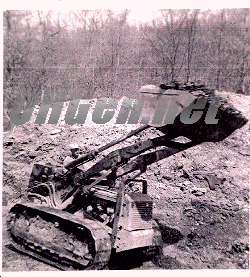|
|
Southeastern Ohio Coal
Industry and History
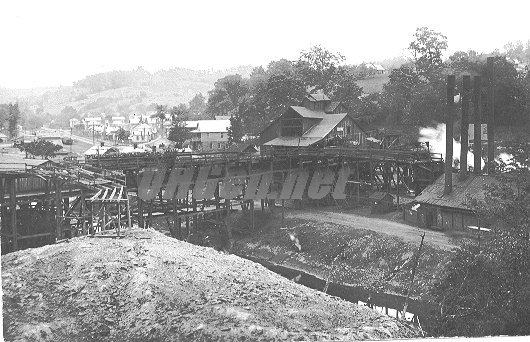
Murray
City coal mine # 5, view towards the lower end of town.
(Photo
postcard owned by Sandra Mitchell-Quinn)
A large part of the history of Athens,
Hocking and Perry counties in Ohio is the local coal industry.
"To
the person not a native of the coal regions, it is difficult to
comprehend how completely coal mining dominated every aspect of the
life and physical appearance of the communities in the coal counties.
At the peak of hard coal mining, patch towns were as
ubiquitous as the breakers and mines. The term "patch town" originated
with the custom of the wives of the miners having small garden patches
to supplement the meager wages of their husbands. These patch towns
were constructed by the mine owners to house the throngs of immigrants
from various European nations who were recruited to work in the mines.
The houses were built cheaply and crudely near to the mine workings so
that the miners could walk to work."
Eric McKeever (see his URL at end of page)
The paragraph above so eloquently describes
the coal mine camp towns of Southeast Ohio
Our
ancestors bravely went to work in the dark, damp coal mines to support
the needs of their growing families and their lives were tough, often
they were cheated out of the pay they deserved by the coal barons of
the industry. Working conditions were dangerous and miners died from
falls of slate. If they were to strike over the poor
conditions they were working in, the coal barons would bring in men
from southern states and foreign countries to fill their positions,
leaving the miners with little options, angry wives and hungry
children. Many miners resorted to making Moonshine to sell
during the prohibition years so they could feed their families. We need
to lift our hard working ancestors names up in history and give them
the honor they deserve for the tough lives they lived in order to
provide for their families.
|
The
Knights of Labor union party, and
United Mine Workers of America was formed in the early 1880's due to
unrest
among mine workers when asked to take a cut in pay mayhem resulted with
miners
striking out against the coal barons (Syndicate). The Syndicate
requested help
from the Governor and he sent in the Pinkerton Guards to protect the
strike
breakers and new laborers which were brought in to replace the striking
miners.
During the mine wars of 1884 some coal mines in New Straitsville, Coal
township,
Perry county and Sand Run in Hocking County, were set ablaze by
striking miners
and some are still on fire to this day. The fires were set in response
to the
mine owners putting out the striking miners and their families from
company
owned housing.
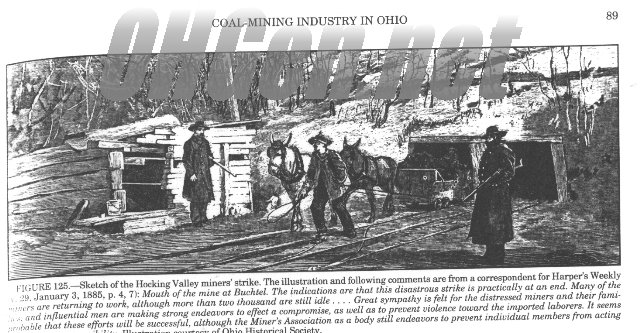
"Mouth
of the Buchtel coal mine
illustration from Harpers Weekly January 3, 1884 p.4, 7. "Mouth of the
mine
at Buchtel. The indications are that this disastrous strike
is practically
at an end. Many of the strikers are returning to work,
although more than
two thousand are still idle...Great sympathy is felt for the distressed
miners
and their families, and influential men are making strong endeavors to
effect a
compromise, as well as to prevent violence toward the imported
laborer. It
seems probable that these efforts will be successful, although the
Miner's
Association as a body still endeavors to prevent individual members
from acting
on their own." Harpers Weekly Illustration from the Ohio
Historical
Society. (History of Coal Mining by Douglas L.
Crowell, 1995 page 89)
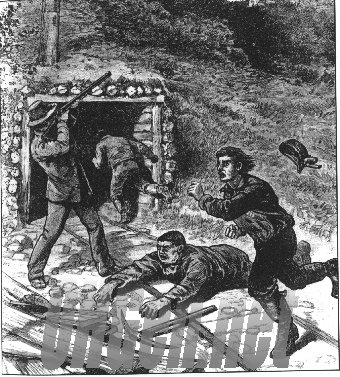
Hocking
Valley Miners Strike 1884 Frank
Leslie's Illustrated Newspaper v. 59 p. 161, 167
"Mine no. 25, a
Pinkerton guard is exchanging
shots with a belligerent party on the hillside, while two or three
terrified
"black-leg" miners scramble frantically for the friendly shelter of
the pit mouth. Guards armed with Winchester rifles protect
the mines and
such Hungarians and Negroes as have been brought in to replace the
striking
miners. Illustration courtesy of the Ohio Historical
Society." (History
of Coal Mining by Douglas L. Crowell, 1995 page 89)
For a
wonderful illustrated history of
the Ohio Coal Industry, contact the Division of Geological Survey,
614-265-6576
to order a copy of Douglas L. Crowell's "History of Coal Mining" book.
I
dedicate this
section to my (and my husbands) hardworking fathers and ancestor
grandfathers
who worked in the Hocking Valley Coal Mines in Southeastern Ohio
Proud
to be a coal miner's Descendant ~ Your webmaster Sandra Mitchell-Quinn
Click
on Underlined names to see Photo of miner
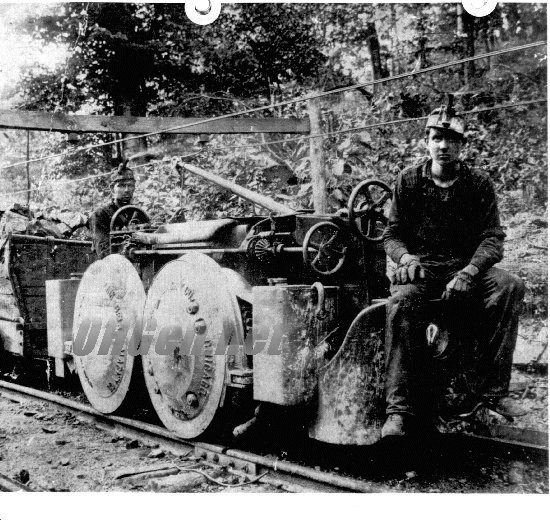
Chester
and son
Clifford Mitchell, motormen
on the
Hocking Valley Coal
Train for the Pittsburgh
Coal Mine #
7
near Murray City, Ohio
Charles
"Ike" Mitchell- coal
miner at Murray City; see photo below; buried in Nelsonville
-
Larry
Lee Mitchell-
worked in the coal mines with his father, coal truck driver
through the late 1970's for area strip mines such at the Peabody Coal
Company; my father
-
George B. Robinson-coal miner at Santoy;
buried in McLuney
-
William
Henry Robinson-
coal miner at Santoy & Orbiston;
buried in Nelsonville
-
William
Stanley Robinson- coal
miner at Orbiston; buried in Nelsonville
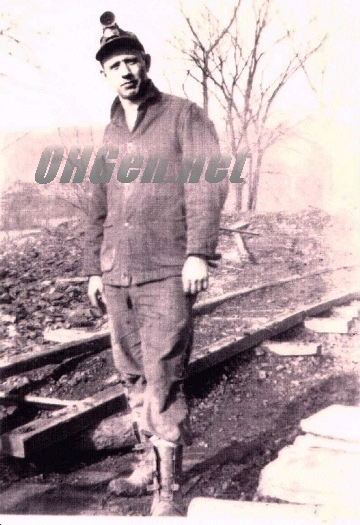
"Stan"
Robinson
working on coal tracks at Orbiston, Ohio
-
Windfield Charles M.
Lee killed
by a fall of slate near Redtown, April 14, 1919 coal
miner at Elizabeth WV & Redtown; buried in Glouster
-
John
William "Billy" Eckels- coal
miner at Parkersburg WV steele district, Buchtel & Murray City;
buried in Nelsonville
-
McClelland
Ellsworth Campbell- coal
miner at Redtown & Orbiston; buried in Nelsonville
-
Thomas
Joseph Davis-
coal miner at Buchtel; buried in Nelsonville
-
William
F. Quinn- coal miner at
Murray City; buried in Nelsonville
-
John
F. Quinn-
born in Ireland coal miner at New Marshfield;
buried in New Marshfield
-
Quinton
Quinn- coal miner at Murray
City; buried in Nelsonville
-
William
Earl Wright-
coal miner at Salem Hollow, diagnosed with Black Lung;
buried in Nelsonville
-
Albert Wright- coal
miner at Salem Hollow, Hollister; buried in Nelsonville
-
Alium Wright-
(killed in
a coal mining blacksmithing accident at Monday a coal miner and
blacksmith at Murray City, Monday
-
Franklin Wright- coal miner at Salem Hollow &
Hollister
-
John Lantz-coal miner at Vinton
County, Jobs, Orbiston, Murray City & Lanzing;
buried in Lanzing
-
James Lantz- coal miner at Murray City &
Lanzing; buried in Lanzing
-
John Loper- coal miner at Brashears;
buried in Carbon Hill
-
Abraham
Lincoln Burnard
killed
by a fall of slate near Hartleyville 1895 a coal
miner at Hartleyville
-
James VanHorn- Coal miner at New Pittsburgh Hollow
Charles
"Ike" Mitchell driving heavy equipment in a Murray City coal strip
mine about 1945.
Photo courtesy of the Ike
Mitchell family copyright 1999 "We sure do miss you Grandpa!"
Please sign
the Coal Miner Stamp Petition!
Let's honor our ancestors! Go to
Eric
McKeever's Pennsylvania
Coal
Mine Stamp Website
HTML
provided by the webmaster
Sandra
Mitchell Quinn ohgen at alltel dot net
copyright
1999-2008 ALL RIGHTS RESERVED
Return
to Athens county Resources





